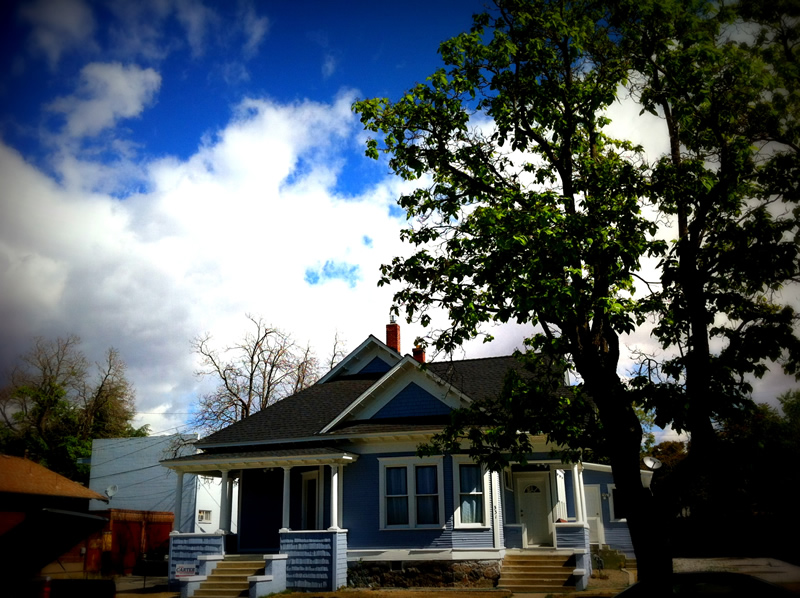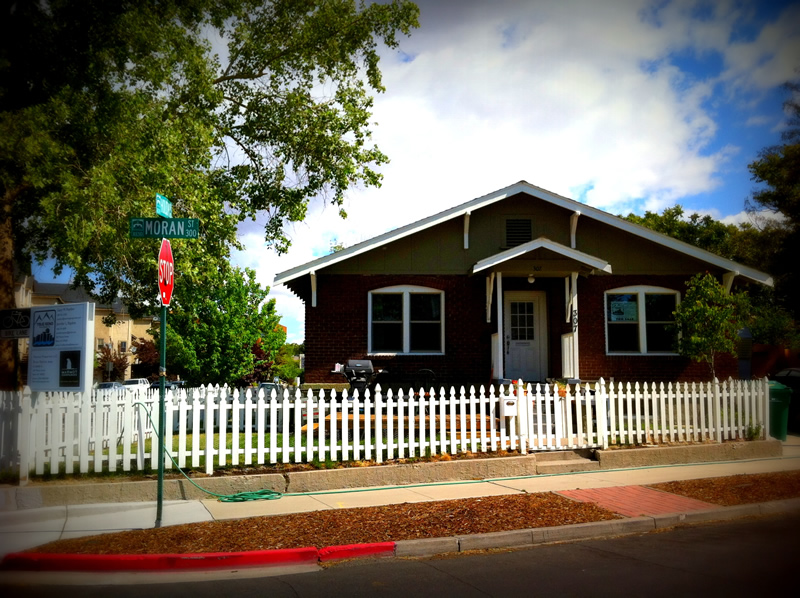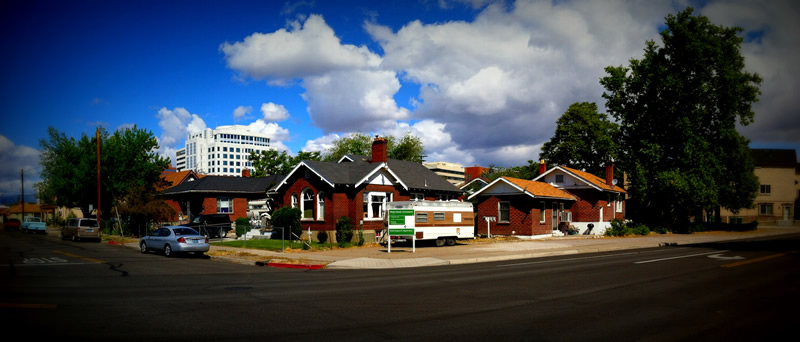Gentrification is often looked at as a 'dirty' word, often because of its evil counterpart, displacement. In the case of West of Wells, I've been able to witness the evolution of this neighborhood for nearly a decade; long enough to gain a fundamental understanding of the long-term trends happening here. The trends can easily be broken down into phases:
2003: The Great Migration
To say West of Wells was a bit sketchy in 2003 is an understatement. Wells Avenue was four lanes and not the most attractive, most side streets were deteriorating, and there was a lot of property for sale in the neighborhood. In the height of the real estate market, when people camped out for three days to reserve one-of-four floor plans in the newest and greatest subdivisions on the fringes of town, many low-to-medium-income renters and homeowners in the yet-to-be-named West of Wells saw it as an opportunity to sell their home in town, use it as a down payment on something twice as big, and flock to the 'burbs. It eerily mirrored the same exact migration that occurred in the 1960s in Reno and other cities nationwide, which nearly destroyed the neighborhood and damaged it for decades when 'suburbs' were invented and families were lured to larger homes with new amenities. The hideous eight-plex apartments you see scattered amongst the beautiful bungalows in West of Wells were all built in the same damaging decade.
Conversely, I bought my home on the edge of Midtown in 2003, because I did not want to migrate to the suburbs. My house was burlgarized three times between 2003-2005. Crack dens existed on almost every block between Holcomb and Wells Avenue. When I moved here, there was already a powerful neighborhood watch group in action, and I joined it. Long story short, we reduced crime, planted over 80 trees with our own hands in the neighborhood, repaired the hsitoric rock wall at Stewart Park, and worked as a group to improve the neighborhood. We eventually, with years of hard work and working with city planners and the city council, designated our neighborhood as a conservation district.
2004-2006: The Madness Peaks - Reverse Migration
The neighborhood wasn't being abandoned during this migration. Amid this flurry of activity, a new wave of people bought into the Wells Ave/midtown neighborhoods right around the same time, myself included. Young homeowners and renters who became fed up with suburban tract home conformity and freeway commutes began to rediscover the neighborhood, and took advantage of the hot real estate market to move INTO town. These urban pioneers bought and rented these old homes, met and formed friendships with the long term residents who had weathered the storm, and are now the members of the Wells Addition Neighborhood Group/West of Wells. There was a lot of sales activity in this neighborhood at this time.
2007-2010: The Crash
Though foreclosure activity in the West of Wells area never really exploded as with other parts of the city, there were still some issues with absentee landlord investors who simply decided to walk away from their properties and let the properties deteriorate and finally go into the foreclosure process. It was a grueling, slow, painful process for the neighborhood because many of us worked hard to renovate our homes only to have totally beautiful historic homes three doors down slowly fall apart. Enter the Marmots!
2010-Present: Renovation Nation
The house next-door to me was one of the casualties of the real estate crash, and in 2010 it was scooped up by Marmot Companies on the courthouse steps, which is how I first met them ...three brothers (Gary, Eric and Bryan Raydon) with a vision for our neighborhood that aligned with ours, and backed by enthusiastic investors. They immediately renovated the property to above-rental standards, and converted the basement to a slick bachelorette-pad. I was told it was pilot project of sorts that was a test for a much bigger operation about to be undertaken. Over the course of the next couple of years, the three brothers comprising the Marmot Companies acquired many more properties, upwards of 60, and gave them second lives as profitable rentals by renovating them.
They took the worst of the worst casualties of the real estate crash and reroofed, rehabbed, restructured, repainted and renovated all of them to a level no one would be unhappy living next to. The end-result? If you take a walk through our neighborhood these days, you'll be hard-pressed to find a crappy looking property. It's not just the Marmots renovating homes though, and that's the real underlying beauty of this neighborhood. We have an active neighborhood group with over 80 homeowners who have engaged in improving the neighborhood through trash clean ups, tree-plantings, park rehabilitation projects and more.
The Mega-Property
So what's next for the Marmots? Well, things are pretty quiet, pretty stable in our neighborhood these days; there are no single-family homes for sale, few properties caught up in foreclosures, and no one is eager to up-and-migrate to the suburbs. There is this little slice of midtown for sale though.....enter the Mega-Property! The Raydons told RGJ they have coined the Mega-Property as 'The Assemblage' but that's way too clinical for me. If you look at the map below (and the banner image above), you'll get a sense of the massive size of the property they are about to close on. The Marmot Companies have it in escrow, it passed all inspections, and they don't foresee any reason why it won't be in their hands within a week.

Map of the L-shaped area Marmot Companies acquired
The area they purchased is HUGE. We're not talking one or two homes, we're talking nearly 25 structures ranging from gorgeous single-family bungalows that just need a little love and attention, to hideous 1960s-architecture-reject apartment complexes. They bought it for nearly $2 million, and plan at least $1 million in renovations to the homes much like they've done with the single-family residences they purchased in West of Wells.

Everything shown in the panorama, from the far left to the far right, is part of the L-shaped piece of midtown/West of Wells being purchased by Marmot Companies.
I'm not gonna sugar-coat it, some these homes are currently some of the most-neglected crop of homes in our neighborhood...and improvements of any kind will make the difference between night and day, because it's such an incredibly large piece of midtown/West of Wells. And that's the real story behind this...the size of the property is what makes it so influential. If the Marmot Companies renovate the homes, reroof them, paint them, demo the unsalvageable ones (which is the plan) etc, it will have a profound positive effect on the neighborhood. Of course, it would be an equally profound effect if they decided to completely demo all the homes and build super-dense multi-unit housing, but I don't feel that's the case. It's not their modus operandi, and the days of Mega-Projects in Reno are behind us, at least for a while.
There are other properties they have renovated, including some my friends have moved into, because they are keeping the rents affordable. Hopefully that trend continues when they renovate the assemblage. Just because we improve the neighborhood doesn't mean we want to suddenly not be affordable.
Coupled with the Carter Bros' large Thoma/Virginia project and rehab of 701 South Virginia, and the amazing Brasserie St. James on South Center, this new Marmot venture encapsulates the West of Wells and Midtown Neighborhoods in a little bubble of development that is progressing slowly enough as to not burst. I'm excited! Bring it on.
The southeast corner of the Mega-Property.





Sounds like a terrific undertaking and good for property values and all that. Just curious about the term "salvageable" . Suppose it means different things to different people. I just keep remembering the City of Reno saying all the things that will be preserved if they are economically feasible and salvageable, like the Mapes, the Virginia St Bridge, and so on. I know the Marmot is far from being like the city, just something I hope will b e considered.